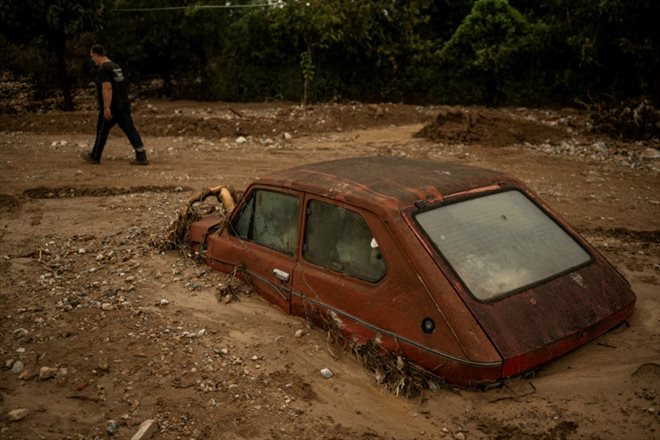A resident of the village of Sotirio (central Greece) hit by floods on September 29, 2023 (AFP/Angelos TZORTZINIS)
On the slopes of Mount Pelion, ravaged by the torrential rains which hit Greece in early September, Thymios Ikonomou struggles with his steering wheel while his pick-up gets stuck in the mud.
On this road strewn with stones, the apple producer ends up giving up climbing the hill.
“There was an apple plantation here. All the trees were washed away by the floods,” this 53-year-old farmer, resident of Zagora, told AFP.
Storm Daniel killed 17 people, hundreds of thousands of animals and caused immense damage in this important agricultural region.
“A hundred trees have disappeared, they were uprooted by the water and ended up in the sea,” also laments Antonis Laskos, 62, another farmer from Zagora.
This hilltop village of 3,500 inhabitants is considered “the apple capital” of Greece.
The fruit produced here, which benefits from a protected designation of origin (PDO), is renowned for its sweet, astringent and refreshing taste and is sold throughout the country.
But this fall, at the Zagora agricultural cooperative, founded in 1916, the joy of previous years gave way to desolation.
“Last year, we had 18,500 tonnes of apples but this year, we will barely exceed 5,000 tonnes,” predicts Julia Papoulia, agronomist of this cooperative which has 800 members.
“So far, there are only 1,300 tonnes of apples (stored) in warehouses and intended mainly for sale on the domestic market,” she assures. “Production will not be sufficient for exports.”
– Zero income –
Entire slopes of the fertile Pelion peninsula, bordered by the beaches of the Aegean Sea and the Pagasetic Gulf, were destroyed by this storm of rare violence attributed by the Greek government to global warming.

Aerial photograph of the flooded village of Sotirio (central Greece) taken on September 29, 2023 (AFP/Angelos TZORTZINIS)
Large trunks of century-old plane trees and uprooted fruit trees were found by the sea.
Bridges also suffered significant damage and the rural road network was 80% destroyed, according to residents of Zagora.
Consequence: like Thymios Ikonomou, some producers can no longer go to their orchards to save what remains of the harvest. “Their income will be zero this year,” laments Mr. Ikonomou.
In Zagora, the National Observatory of Athens recorded a record rainfall of 1,096.2 mm between September 4 and 8.

A resident cleans his house after devastating floods in Volos, Greece, September 29, 2023 (AFP/Angelos TZORTZINIS)
On the day of September 5 alone, 759.6 mm of rain fell, while the previous record was set at 231 mm in 2018.
A hailstorm immediately followed these torrential rains.
Last week, a second, less violent storm hit this region of Thessaly, causing further damage.
Summoned to react to the anger of many residents of the region, the government of Kyriakos Mitsotakis promised that nearly 690 million euros would be devoted to restoring infrastructure affected by the floods and fires which also hit the Greece during the summer.
– hindered transport –
Road restoration efforts are underway, but the damage is so extensive that it is impossible to repair everything.

A car partially buried after the passage of storm Elias in Agria, central Greece, September 28, 2023 (AFP/Angelos TZORTZINIS)
The only bridge still standing in the area cannot support the 45-ton trucks normally used for transportation, according to cooperative president Yiannis Kravvaris.
“We will have to use smaller trucks, which will considerably increase costs,” he fumes.
But even before this natural disaster, the harvest of the famous dark red apples was not looking good due to a particularly rainy spring.
“We had a lot of diseases on the trees because of frequent rains in June,” explains Kostas Zervas, 50, who works on a farm where the majority of apples fell to the ground.
“And the winter was mild. Apple trees need cold, 800 to 1,600 hours of frost per year,” he explains.
© 2023 AFP
Did you like this article ? Share it with your friends using the buttons below.




